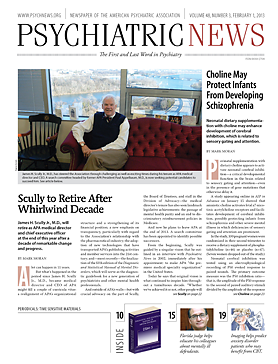Physicians die by suicide more frequently than nonphysicians, a disturbing phenomenon that’s been well documented for several decades in the United States. But researchers say details about factors that may contribute to those suicides are lacking.
Katherine Gold, M.D., M.S.W., an assistant professor of family medicine in the Department of Obstetrics and Gynecology at the University of Michigan, and colleagues identified the National Violent Death Reporting System (NVDRS; see box on page 23) as a tool for analyzing the details of physician suicide.
“The NVDRS offers critical, and heretofore rarely available, data on psychosocial, psychiatric, mental health care, medical comorbidity, and substance abuse variables associated with suicide,” they wrote in the November 1, 2012, General Hospital Psychiatry. “An analysis of these data could contribute to a significantly better understanding of the magnitude and nature of the problem of physician suicide and could lead to new educational, preventive, and clinical interventions.”
Gold and her colleagues set out to do just that. They identified 31,636 suicide victims aged 18 and older in the database, 203 of whom were physicians or residents in any specialty. When they analyzed the details of those cases, their results were perplexing: Mental illness was found to be an important comorbidity for physicians—as it was for nonphysicians—but postmortem toxicology data showed low rates of medication treatment. The physicians had significantly higher rates of antipsychotics, benzodiazepines, and barbiturates in their systems than the other suicide victims, but not antidepressants. Toxicological testing was unable to determine whether the substances that were detected were intended to be therapeutic, recreational, or toxic.
The finding of barbiturates, said the researchers, is “particularly significant because of…infrequent use for therapeutic purposes and known lethal potential. The equally dramatic increased likelihood of measurable antipsychotics being found is unclear as to its significance….”
Gold told Psychiatric News that unpublished data from the study indicated that, of the victims who appeared to have some type of mental health disorder, as determined from police reports or from toxicology testing that indicated the presence of antidepressants or antipsychotics in non-overdose deaths, 81 percent of physicians and 79 percent of nonphysicians had a mood disorder: depression, dysthymia, or bipolar disorder.
But where were the antidepressants that would suggest an attempt to treat depression? “We were surprised to find that physicians are more likely to have an unknown mental illness [diagnosed by postmortem toxicology findings], but less likely to have antidepressants in their system,” she said. “But for physicians, there is a lot of stigma associated with treatment for mental illness. In many states, a mental health disorder in a physician is still considered an impairment, just as substance or alcohol abuse might be.”
One difference Gold and her colleagues identified between physicians and nonphysicians was the preferred method: Both groups chose firearms as the most common method, but for physicians, poisoning was next, followed by blunt trauma, and asphyxia, which included hanging. For nonphysicians, asphyxia was the second most common method of choice, then poisoning, and lastly blunt trauma.
They were able to identify psychosocial stressors that differed between physicians and nonphysicians. Having a job problem contribute to the suicide predicted an increased likelihood of being a physician, while the death of a friend or family member or a crisis in the last two weeks of life were significantly associated with being a nonphysician.
Gold and her colleagues theorized that “the reduced risk of a recent loss or crisis and the increased risk of a job problem may reflect physician experience dealing with death and loss but an inability to cope with problems related to their identity as a physician.… For someone whose work helps to define his/her personal and professional identity, a crisis in a work situation might feel more threatening than for someone whose personal identify was less reliant on work satisfaction.”
Prior studies, they noted, have found a correlation between patient demands, role conflicts, lack of control over working conditions, degrading experiences or harassment, and conflicts with coworkers as significant risks for suicidal ideation among physicians.
Gold and her colleagues hope their work will lead to programs for physicians addressing common stressors, but admit there are many obstacles to such programs. “There are multiple barriers to appropriate help-seeking, diagnosis, and treatment of mental health problems among physicians due to stigma and possibly lack of social recognition of the problem. Physician knowledge of pharmaceuticals, dosing, and lethality, as well as greater access to medications with lethal potential, present a further challenge in designing an effective plan to reduce physician suicide,” they concluded.
The authors reported no specific source of funding for the study. ■

